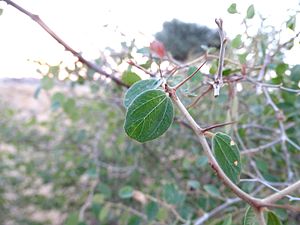Note: This is a project under development. The articles on this wiki are just being initiated and broadly incomplete. You can Help creating new pages.
Ziziphus nummularia - Balakapriya
Balakapriya or Ziziphus nummularia is a species of Ziziphus native to the Thar Desert of western India and southeastern Pakistan and south Iran. Common names are Mulluhannu, Bhu-kartaka, Zariab etc.
Contents
Uses
rheumatism, eye diseases, gonorrhea, diabetes, gout, diabetes.
Parts Used
Chemical Composition
Seed contains anthraquinones,namely; (aurantio-obtusin, chryso-obtusin,obtusin, chrysoobtusin-2-O-beta-glucoside,physcion,emodin,chrysophanol,obtusifolin,obtusifolin-2-O-beta-D-glucoside, alaternin 2-O-β-Dglucopyranoside)15, brassinosteroids(brassinolide, castasterone, typhasterol,teasterone, and 28-norcastasterone), andmonoglycerides (monopalmitin andmonoolein)16. Phenolic glycosides such asrubrofusarin triglucoside, nor-rubrofusaringentiobioside, demethylflavasperone gentiobioside, torachrysone gentiobioside,torachrysone tetraglucoside and torachrysoneapioglucoside were also isolated 17[1]
Common names
| Language | Common name |
|---|---|
| Kannada | Mulluhannu, Paraji, Parapele |
| Hindi | Jhar Beri |
| Malayalam | |
| Tamil | Korgodi, Parpalli-gidda |
| Telugu | Nelaregu, Jitta reni |
| Marathi | NA |
| Gujarathi | NA |
| Punjabi | NA |
| Kashmiri | NA |
| Sanskrit | Aja-priya, Balakapriya |
| English | Avaram senna |
Habit
Identification
Leaf
| Kind | Shape | Feature |
|---|---|---|
| ovate | elliptic | oblique or rounded at base, serrate at margin, acute or obtuse at apex, 1-2.5 x 0.5-1.8 cm, glabrous or tomentose above, tomentose to white-wooly beneath, 3-nerved at base |
Flower
| Type | Size | Color and composition | Stamen | More information |
|---|---|---|---|---|
| bisexual | 2.5 cm long | bright yellow | 5-20 | The racemes are few-flowered, short, erect, crowded in axils of upper leaves so as to form a large terminal inflorescence stamens barren; the ovary is superior, unilocular, with marginal ovules. |
Fruit
| Type | Size | Mass | Appearance | Seeds | More information |
|---|---|---|---|---|---|
| short legume | 7.5–11 cm long, 1.5 cm broad | clearly grooved lengthwise, Lowest hooked hairs aligned towards crown | oblong, obtuse, tipped with long style base, flat, thin, papery, undulately crimpled, pilose, pale brown. | 12-20 seeds | {{{6}}} |
Other features
List of Ayurvedic medicine in which the herb is used
- Vishatinduka Taila as root juice extract
Where to get the saplings
Mode of Propagation
How to plant/cultivate
Plants reach about 3 m height with 3.5 cm stem diameter in 2 years, in 4 years about 5 m height and 7 cm stem diameter. Flowering and fruiting is almost throughout the year, but in India there are usually two main flowering periods, one in the early monsoon and another in the late monsoon.[3]
Commonly seen growing in areas
dry regions of India, sea coast, dry zone in Sri Lanka.
Photo Gallery
References
External Links
- Pages with reference errors
- Ayurvedic Herbs known to be helpful to treat rheumatism
- Ayurvedic Herbs known to be helpful to treat eye diseases
- Ayurvedic Herbs known to be helpful to treat gonorrhea
- Ayurvedic Herbs known to be helpful to treat diabetes
- Ayurvedic Herbs known to be helpful to treat gout
- Herbs with Root used in medicine
- Herbs with Bark used in medicine
- Herbs with Leaves used in medicine
- Herbs with common name in Kannada
- Herbs with common name in Hindi
- Herbs with common name in Tamil
- Herbs with common name in Telugu
- Herbs with common name in Sanskrit
- Herbs with common name in English
- Habit - branched shrub
- Index of Plants which can be propagated by Seeds
- Index of Plants which can be propagated by Cuttings
- Herbs that are commonly seen in the region of dry regions of India
- Herbs that are commonly seen in the region of sea coast
- Herbs that are commonly seen in the region of dry zone in Sri Lanka
- Herbs



